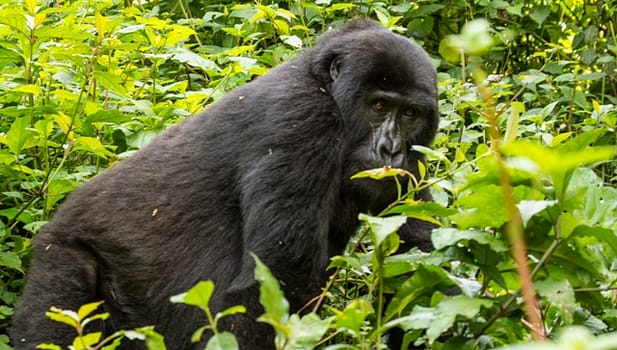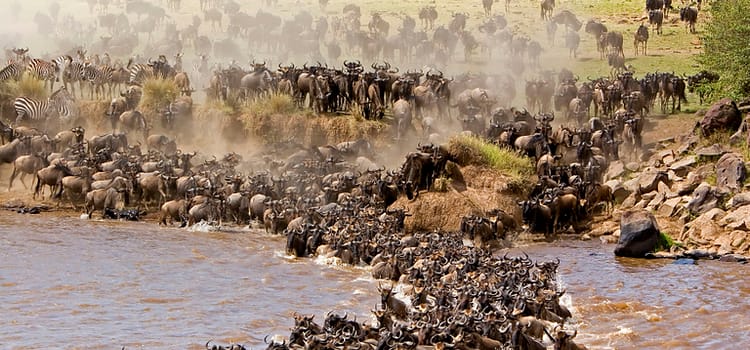A Guide to the Serengeti – Masai Mara Wildebeest Migration
The Wildebeest Migration
This is one activity which is on top of every wildlife safari lover’s bucket list. Yet still, there are other thousands of travelers around the world who have experienced it once, twice or more but still can’t wait to be back to either Serengeti or Masai Mara to catch one more glimpse of the greatest wildlife spectacle on earth.
A wildebeest’s journey begins at birth and only ends at death. Unknown to many, the annual wildebeest migration that involves over 1.5 million wildebeests accompanied by Zebras and other antelopes is more of a life time process rather than an annual event. However, it is the movement between Serengeti in the north and Masai Mara in the south that gets most of the attention, more so because of the epic dives across the Crocodile infested Mara River in search of greener grazing pastures and water on the other side.
In this edition, we take you through the A to Z of the wildebeest migration.
January to March: Wildebeest Calving Season
This is the time when the marauding gnus gather on the wider Ngorongoro conservation area, south of the Serengeti after their long and tedious journey back from the Masai Mara, through the northern part of the Serengeti. At this time, the short rains have just ended and the area has adequate grass and watering spots. The gnus can be seen moving between the open grass savannah, the bushes and even swamps. Calving, one of the most important and interesting chapters in a Gnu’s life happens here between February and March, in what is popularly referred to as the wildebeest calving season. January is a hot month, and most of the females are heavily pregnant. This means that they will soon be giving birth, and tender grass is needed for the young calves to feed on. The Gnus are therefore waiting for the signs of the first rains. Their movement is therefore dictated by signs of rains, and no one knows how they sense the rains. It has been observed in the last few years that Wildebeests can delay giving birth depending on the weather patterns. In years when it has been very dry, and rains have delayed, they have also taken their time before introducing the young ones to the cruel African Savannah. Their movement during this season can be unpredictable, as they can move swiftly from one area to another within days. Once the rains begin, the females give birth (almost all at once) in what is referred to as synchronized birthing. During this window, as many as 8,000 calves are born every day for a period of about 3 weeks, with over half a million new wildebeests being born by the time it’s over.
It’s now rainy and there is enough pasture, and new calves born, translating to lesser movement of the animals. This is a very popular travel season and you have a high chance of witnessing the migration and wildebeest calving season in the Lake Ndutu and Lake Masek area. Considering the fact that a Gnu’s journey is mainly instinct led, this may vary by 10 or 20 kilometres, but without fail the wildebeest herds gather between Ndutu, Matiti Hill, Naabi Hill, the Goll kopjes to the east and Olduvai Gorge. If you want to stay here during this season, there is a selection of a lodge as well as permanent and semi-permanent tented camps to choose from.
Understanding the Synchronized birthing by Wildebeests:
One would wonder why Wildebeests would give birth during the February to March window, and almost all of them at a time. It’s only the Wildebeests that could answer that better, so it’s unfortunate that humans don’t have a way of communicating with them. However, as humans we are blessed with the ability to study and interpret nature.
Wildlife specialists consider the giving birth to many calves at the same time as the Wildebeest’s strategy to saturate predatory activity, as many calves born at the same time have a higher chance of survival than if the births were spread across the year. This is because predators that await the birth of the weak and powerless calves (easy prey) cannot be able to kill all the new born s. Most survive this and the future generation of wildebeests begins here.
It would not be fully correct to say that predators enjoy easy kills. Over the years, Wildebeest mothers have instinctively known to give birth on the shorter grass plains, from where it is easier to spot predators approaching. They are joined by other mothers who form protective barricades around the most vulnerable newly borns in order to ensure that they have a greater chance of survival. If you are in Serengeti around this time, it is not unusual to see protective mothers trying to fight back when big cats like Cheetahs and even Hyenas attack.
With most of the new calves being born at the beginning of the long rains season, the Serengeti teems with soft green grass which makes for a succulent diet for the young calves. As you will note later in this article, the calves need to be strong enough in readiness for the long, risky and tedious journey to Masai Mara. This freshly sprouted grass is therefore important to the new born Wildebeests, meaning that this is an ideal period for them to be born, as they have a better chance of survival into adulthood.
It has been noted that its not only the Wildebeests that give birth around this season. Zebras, Buffalos, Gazelles, Cheetahs, and even Lions are being sighted commonly nursing young ones so you can expect to see a lot of calves, cubs, and foals if you are visiting Tanzania during this time.
April and May: April marks the peak of the long rains season. The wildebeests and their weeks old calves are now following the grazing paths from Southern Serengeti towards the central plains. They will be spending the next two months traversing the central Serengeti plans as they graze. From Naabi Hills all the way to Seronera, Turner Springs and Lake Magadi, herds comprising of different herds of wildebeests can easily be sighted in Central Serengeti during this season, and spreading all the way to Kusini, Simba Kopje and Moru Kopje areas. There is a high presence of big cats here so you can expect breath taking predator and prey actions if you visit during this month. This being the most visited part of the Serengeti there are several lodges and tented camps to choose from.
These include Serengeti Serena Lodge, Kusini Camp, Serengeti Sopa Lodge, Seronera Wildlife Lodge, Serengeti Kati Kati, Ole Serai Luxury Camp- Turner Springs, Ole Serai Luxury Camp- Moru Kopjes, Serengeti Safari Lodge, Four Seasons Serengeti Lodge, Sametu Camp, Serengeti Heritage Camp among many others.
It is important to note that this is a muddy season so you should be ready for some adventure in the black cotton mud.
By end of May, the central Serengeti plains are becoming dry, and the pastures depleted. The migration has by now gained momentum and the migrating herds move towards the Grumeti River on the western Serengeti corridor. Due to the dispersal of the moving herds, it might take you hours driving between the leading herds and the tail end. Some herds may already be in Mbalageti and others as far as Nyamuma Hills. Huge herds can be seen congregating along the pools and channels of the Grumeti River which they need to cross in order to continue with their journey. (The River hasn’t had much water around this time in the last few years but that could change in the future). The River is crocodile infested but you may not see spectacular crossings and encounters like you might see on the Mara River.
There are not many lodges located West of the Serengeti so its recommended that you book your safari as early as possible. Some of the Lodges and camps located in this area are Mbalageti Lodge, Grumeti Migration Camp, Olakira Camp, Asanja Grumeti Camp and Kirawira Serena Camp.
From July, the Serengeti is now dry, and the landscape arid. This is the mating season, and the time the migrating herds are crossing the Mara River. There is no better time to witness River Crossings. The migration is now moving faster in pursuit of water and greener pastures.
August is the month when the migration is most constant. You have a great chance of witnessing River Crossings both from the Serengeti and Masai Mara side. The herds can be seen north of the Serengeti, south east of Masai Mara around the Sand River and in the central Masai Mara plains. They will then spread over moving to the Mara Triangle and other areas of the vast reserve. Between now and September, the Mara will be home to big herds of the migrating herds, although some have been seen to remain in Northern Serengeti over the last few years. (This has been occasioned by irregular rain patterns that ensure that there is adequate pasture both in northern Serengeti and Masai Mara). Herds have even been seen crossing to the Masai Mara only to turn towards the Serengeti after a few days, and vice versa). During this season, there are a few permanent and semi-permanent tented camps strategically located along the Kogatende and Bologonja areas in northern Serengeti.
In Masai Mara, there are several lodges and camps that offer you close proximity to where the action is taking place. In Central Maasai Mara, there are many lodges and camps to choose from, all located a few hours drive to the Mara River with en route game drives. If you want to be closer to the River, Ashnil Mara Camp, Mara Serena Safari Lodge, Entim Mara Camp, Governors Camp, Mara Crossings Camp, Mara River Camp, Rekero Camp, Mara Intrepids, Mara Explorer are some of the options to choose from. If you want to combine big cat sightings and the migration trail, camps located along the Talek River would be ideal. These Include, Fig Tree Camp, Mara Leisure Camp, Tipilikwani Mara Camp, Base Camp Masai Mara, Il Keliani, Azure Mara Haven and Mara Simba Lodge. They are all located along a prime game viewing area, and about two hours to some of the major crossing points.
In August and September, the concentration of Lions, Cheetahs, Leopard, Cheetahs and other predators near the migrating herds is high. You are likely to experience successful hunts, find predators or scavengers on a kill, or resting by the shades after enjoying a heavy meal.
By October, the migration is almost completing the cycle and scattered herds are heading southwards. By early November they have moved from Kenya to the eastern limits of the Serengeti. They retrace their steps north via Lobo and by December, they are spread around the Southern part. From here, they are joined by herds of Zebra and other plains game and are venturing deep into the southern plains where the vegetation is lush after the rains. The calving season will soon begin, and the Great Migrations continues to move rhythmically in a clockwise direction.
In as much as we have tried to be as accurate as possible, please note that this is only a guide based on our observation of the wildebeest migration over the years. The migration is however a natural, instinct led activity mainly motivated by pursuit of pasture and water. The wildlife moving patterns may therefore vary from time to time. We are available to offer tailor made safari packages based on accurate to near accurate movements.
Need a safari customized to suit your taste, budget and pace? Write to us on: holidays@esseniasafaris.co.ke.


